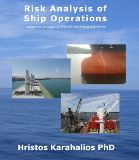Lashing and Securing of Coils & Other Steel Cargoes
The carriage of such units requires sufficient lashing provided by the crew or the stevedores. In any case, the ship’s master has the responsibility for proper stowage of the cargo, either by interfering or silently approve lashing methods and practices. The IMO cargo securing manual, SOLAS 74 regulations VI/5 and VII/6, set the international standards for cargo securing on ships. Additionally, the guidelines contain details, to take into account the provisions of the:
• Code of Safe Practice for Cargo Stowage and Securing (the CSS Code), as amended
• Code of Safe Practice for Ships Carrying Timber Deck Cargoes,
• Codes and Guidelines for Ro-Ro Vessels, and Container Vessels.
The aim of cargo securing is to prevent any cargo movement at sea voyage. Adverse weather conditions may break weak lashing material. A rule-of-thumb for lashing strength is that the SWL nominal values as shown in the certificates of lashing materials used should at least have an aggregate value equal to the static weight of a cargo item. UK P&I Club (2006) provides further explanation stating that the safe working load is arrived at by dividing by 3 the minimum breaking-load/slipload/ holding power of the lashings. Consider a weight of 6 tonnes that needs to be secured. Following the above rule, the lashing materials used should have a holding power of 2 tonnes.
However, lashing may fail for several reasons. The most recognised is the poor quality of lashing material (or uncertified) or securing components due to cost reduction may cause cargo shifting. Relevant crew experience is a factor that may assure proper lashing. However, human errors may occur from the stevedores or the crew when
there is commercial pressure for fast loading. Such pressure may lead to the use of inappropriate or deteriorated material, and the number of lashing points. Concerning stowage, unbalanced weight distribution could also damage the lashing arrangements.
Read more here:
Risk Analysis of Ship Operations: Research and Case Studies of Shipboard Accidents
American Club, Transport Guidance for Steel Cargoes
UK Lashing and Securing Deck Cargoes

